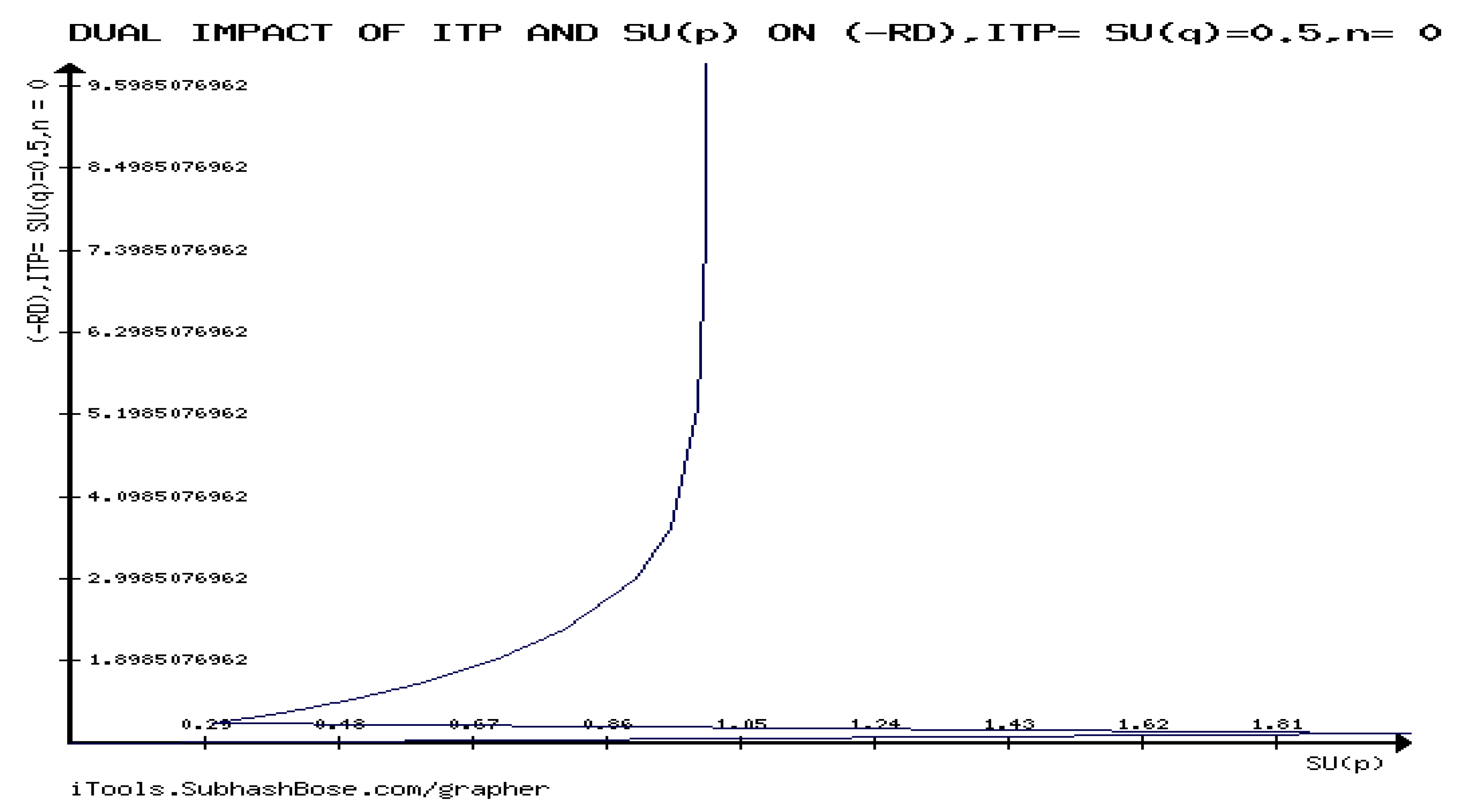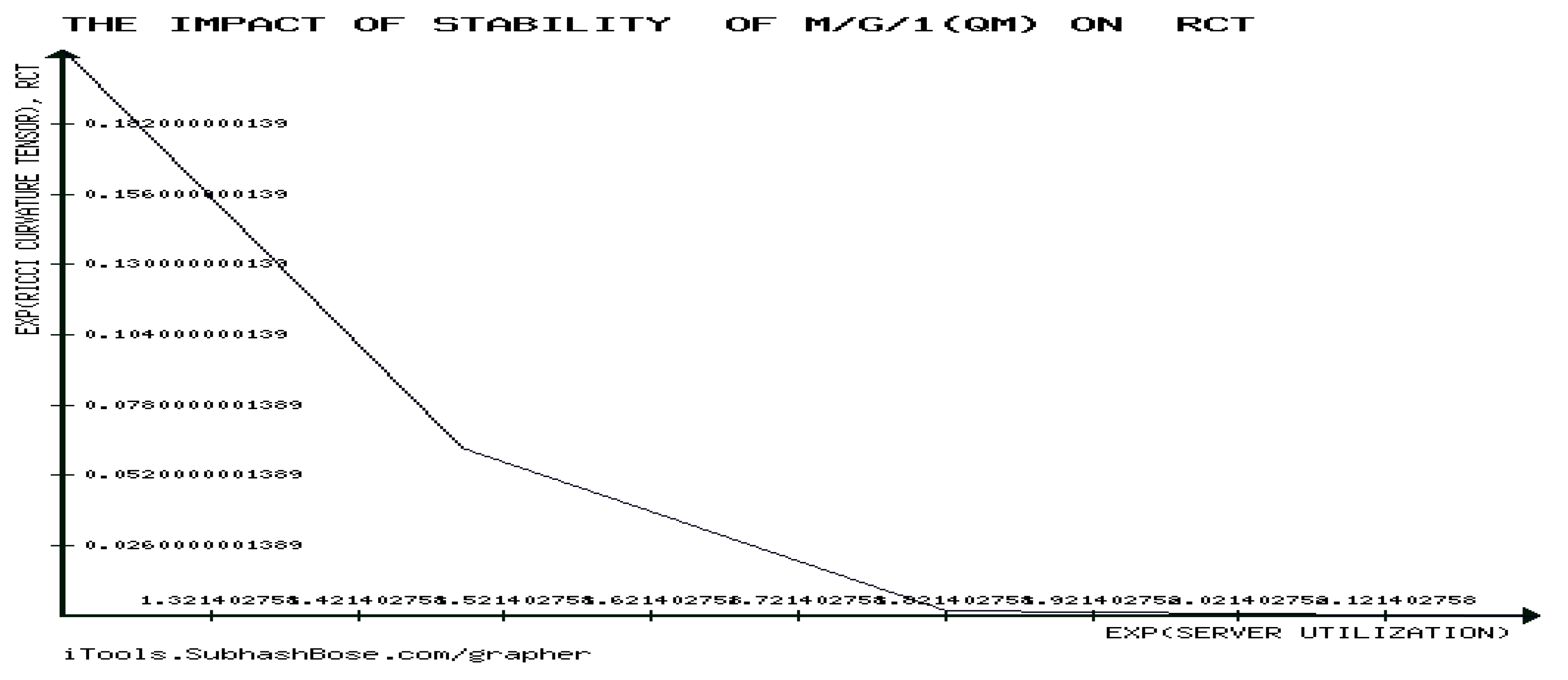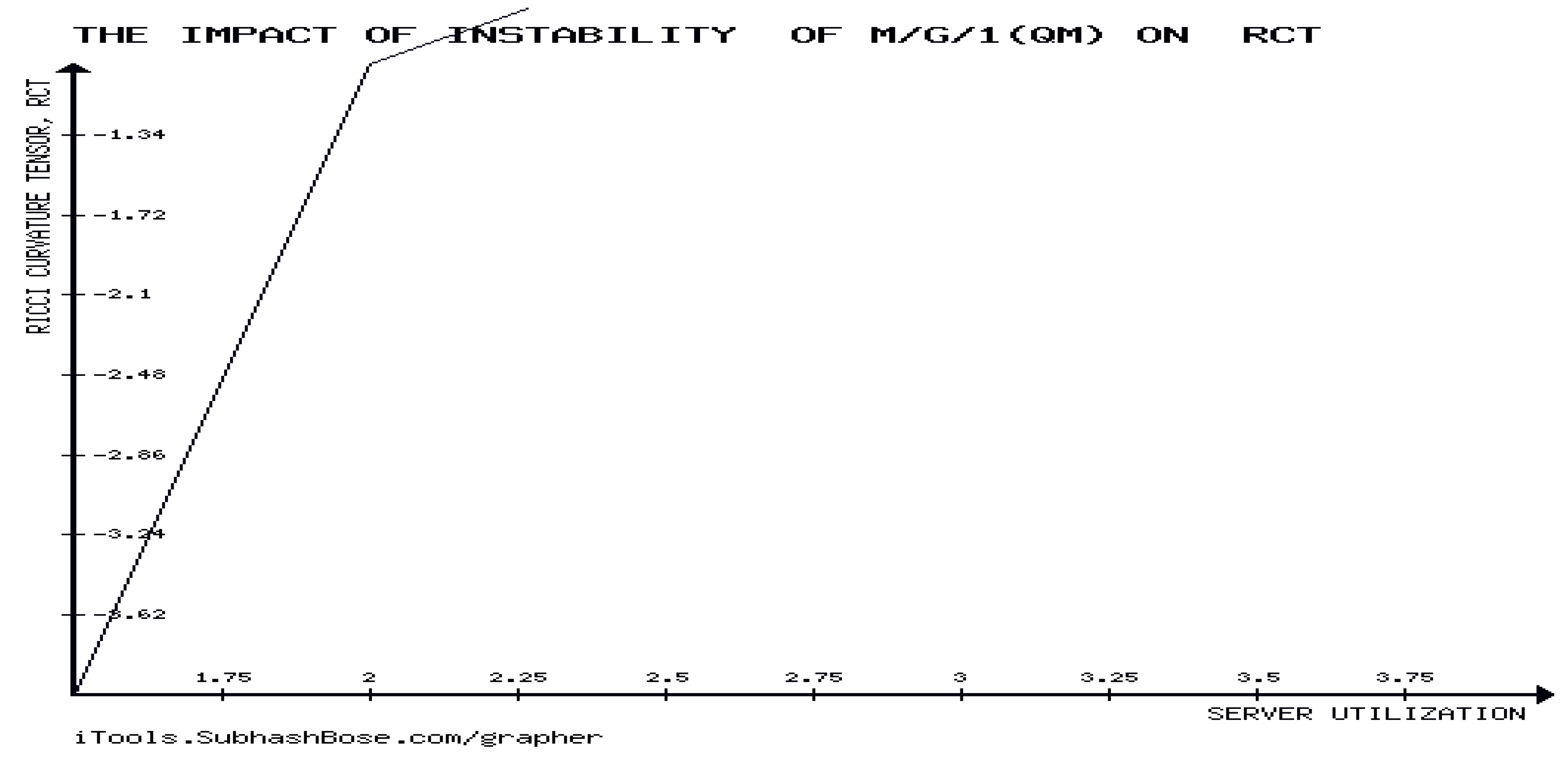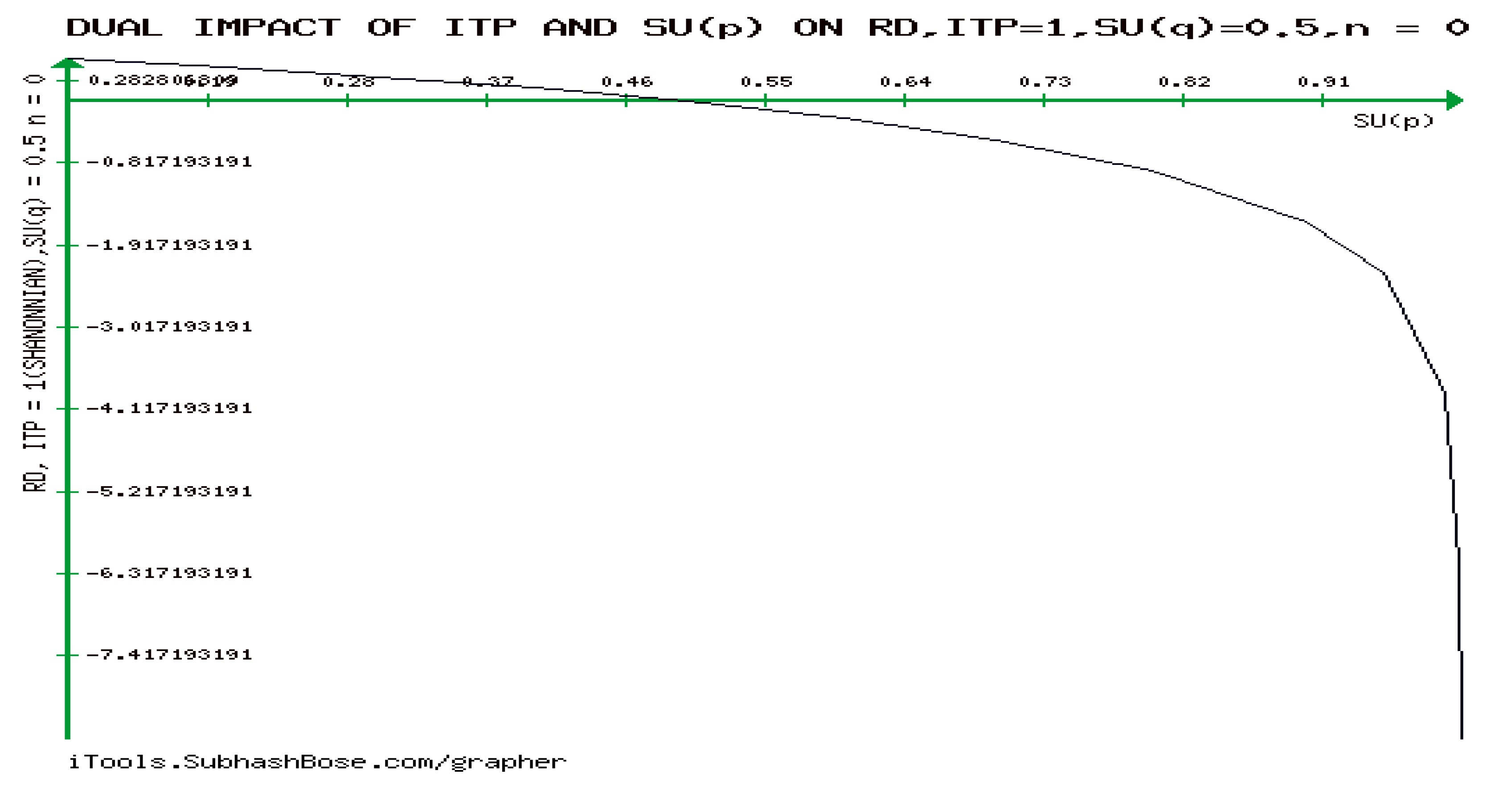6. Investigations of the Developability of the Stable M/G/1 QM ,RICCI CURVATURE (RCT) tENSOR and QT-IG Unifiers
6.1. Investigation of Developability of M/G/1 QM and Finding Its Ricci Curvature Tensor (RCT)
Theorem 6.1
The stable M/G/1 QM
i) Has a zero 0-Gaussian curvature, for which the stable M/G/1 QM would be developable.
ii) Has a non-zero Ricci Tensor
iii) Is non-developable minimal surface under Monge Technique, with a zero Mean Curvature
iv) Is developable under Angular Technique if and only if M/G/1 QM unstable
v) If the underlying QM is unstable, then the Mean Curvature is negative under Angular Technique. The converse statement is not always true.
vi) The first principal curvature,
under the Angular Technique satisfies the inequality
vii) The second principal curvature,
under the Angular Technique.
viiii) Under the Angular Technique,
the second principal curvature,
tends to zero as
Proof
It could be verified that,
(6.3)
. Hence,
, which proves that the underlying QM is developable subject to
.
Engaging the same procedure as in (6.2), we have
(6.6). The corresponding Ricci Curvature Tensor is given by
As
The highlights the significant influence of instability in a specific type of the underlying QM, by providing supporting evidence on how RCT is significantly impacted by the stability analysis of the system. The also shows that
, represented by
,affects the behavior of RCT, and Figure 21 demonstrates that the stability phase of the M/G/1 QM causes RCT to decrease as
ρ increases.
whereas in Figure 22, RCT increasability in
is caused by the underlying QM’s instability.
iii) Following (3.14) and (3.15), it is clear that
Thus, we have
(3.15)
And the Mean Curvature is
Therefore, it is obtained that
Since = it follows by the non- developability of the underlying QM and its minimal surface under Monge Technique.
Hence, iii) is done.
iv) Following the Angular Technique, it can be verified that the calculations of
the principal curvatures
are determined by
The axial rotator angle
reads as
This implies,
It appears from (6.10), that
if and only if
The second possibility (
generates a contradiction as
is never negative.
Linking the findings of (6.13) and (6.15) completes the proof of iv).
As for v), it has been obtained that
It is clear that holds for all the possible values of Consequently, if or (equivalently, the underlying QM is unstable), itid="FD99
follows that To prove the necessity condition, assume that . This generates two possibilities:
The first possibility, . This implies . Hence, M/G/1 QM is unstable.
The second possibility, . This implies . Hence, M/G/1 QM is stable.
This justifies that the converse statement is not always true. The proof of v) is complete.
Since the underlying M/G/1 QM is assumed to be stable. Hence, Thus, we have
Therefore,
. Consequently,
By (6.17), it holds that vii) we have by (6.9), The stability of M/G/1 QMenforces the condition to hold. The negativity of is clear.
viii) Immediate from (6.15).
6.2. Revealing Novel QT-IG Unifiers and Discovering Their Algebraic Structures
Throughout this section, the following novel unifiers between both queueueing theoretic and information geometric structures of the stable M/G/ 1 QM are established by the following two unifiers,
Theorem 6.2.
For the above devised unifiers (c.f., (6.18) and (6.19)), it holds that
i)
is a well-defined function
is one-to –one.
iv)
is onto
v)
is bijection, with animaginary inverse
determined by
where
vi)
is a well-defined function
isone-to –one
x)
is onto
xi)
is bijection, with an imaginary inverse
(i.e., a complex number)determined by
where
xii) The underlying QM has inverse of
satisfies
xiii) The underlying of inverse of
satisfies
xiv)
in
are undecidable.
xv)and is never decreasing in To prove i), it is enough to show that for all such that , then should never be distinct.
Let
. After some lengthy mathematical steps, (6.26)id="FD99
reduces to
Equation (6.28) generates three possible cases:
By
following mathematical analysis it holds that
Therefore,
which contradicts (6.29).
Based on the above analysis and by (6.29), i) follows.
ii) we have by (6.18),
Since
, it could be verified that
(6.33)
The case is clear. Also, for it is immediate that . This completes the proof of ii).
iii) It suffices to show that for all
such that
, then
holds. The proof is clearly immediate from (6.29).
iv) From the definition,
. Every
is characterized by
This clearly proves the surjectivity of
Hence, iv) follows.
v) Clearly,
is a bijection. To calculate the inverse of
. Define
. Hence,
. Let
. Then, we have the cubic equation:
Following the method for solving cubic equations (c.f., definition 2.14), we have
The solution of (6.34) is characterized arbitrarily by
The discriminant of the cubic equation
After some lengthy calculations, it can be verified that
where
By (6.20), we have
where This completes the proof.
To prove vi), it is enough to show that for all such that , then should never be distinct.
Let . Then , such that This implies
Equation (6.46) generates three possible cases:
By following mathematical analysis,
which directly implies by (6.47)
Based on the above analysis, vi) follows.
vii) It suffices to show that for all such that , then holds. The proof is clearly immediate from (6.47).
viii) Since M/G/1 QM is stable, the condition and a similar proof to that in ii), viii) follows.
The proof of x) is analogous to iii).
xi) We have (c.f., (6.21)).
Hence,
(6.52)
By (6.43),
Moreover, by the above step, it is clear that
Thus, it is obtained that
This completes the proof.
xii) The stability of the underlying QM implies
We have
Hence, (c.f., (6.23)). So, (6.56). Also, it can be verified that (6.57). Consequently, xiii) will follows.
xiv) we have
=
. Hence,
if and only if
. By (PT) 2.15,
is increasing(decreasing) in
if and only if
. According to stability of M/G/1 QM,
. Hence, it follows that
.Consequently, xiv) follows:
xv) We have = . Hence, if and only if . By (PT) 2.15, is increasing(decreasing) in if and only if . According to stability of M/G/1 QM, . Consequently, xv) follows.
8. RICCI SCALAR, , THE CORRESPONDING THRESHOLD THEOREMS FOR THE UNDERLYING CURVATURES AND THE DUAL QUEUEING IMPACT ON THE EXISTENCE OF THE INVERSE FISHER INFORMATION MATRIX (IFIM)
Theorem 8.1 The underlying QM satisfies:
i)The Ricci scalar subject to Angular Technique,
is determined by
where
= 1 –
and
define server utilization and Squared coefficient of variations respectively.
ii)
if and only if
iii)
if and only if
iv) M/G/1 QM is unstable
(c.f., (2.45)) must satisfy:
v)The Spacetime curvature(Einestein Tensor) subject to Angular Technique,
is determined by
where the components
are determined by
where
is the curvature parameter (c.f., definition (2.8))
vi)The stress-energy tensor ϖ is devised by
where the components
are determined by
where
is the universal gravitational constant,
is the speed of light
xii)is forever decreasing in (curvature parameter) whether M/G/1 QM is stable or unstable. If , the decreasability of in is undecidable.
xiii)is forever increasing(decreasing) in if M/G/1 QM is stable, .
xv)
is forever decreasing in
if the either one of the following branches hold:
xvi) is forever increasing in .
xvii) is forever increasing(decreasing) in if and only if 1(). If , the decision is undecidable.
Proof
i)Immediate by (6.9) and (2.44).
ii)By i), . Hence, if and only if . Since, 1, the required result follows.
iii)Since M/G/1 is a stable QM, holds. This implies for all ( if and only if . By , the proof follows.
iv)M/G/1 QM is unstable if and only if
, or equivalently
. This holds if and only if
This is equivalent to [1
]
By (2.46),
-
Hence, it follows that
Using (3.3) of Theorem 3.1, (6.50 of theorem (6.1) , (8.1) together with (8.18), (8.19), (8.20) and (8.21), the proof of v) and vi) will follow.
vii)It could be verified that:
if is satisfied satisfying , which or . Following the preliminary theorem (PT) 2.15, this implies is increasing in if and only if . For or , this enforces or , which violates the underlying QM’s stability, or , this enforces , which guarantees the stability of M/G/1 QM.
On the other hand, if , it holds by (PT) 2.15, that is decreasing in if and only ifthere exists satisfying , which . For or , this enforces or , which indicates the underlying QM’s instability. Moreover, or , this enforces , which violates the stability of M/G/1 QM.
Following the above analytic results, vii) and viii) are immediate.
Undertaking similar mathematical mechanism as in vii) and viii), the proof follows.
xi) After some mathematical manipulation, we have
(8.25) provides an evidence that for all . Applying (PT) 2.15, shows that is forever increasing in . This is applicable for stable and unstable M/G/1 QM, with (since violates the continuity requirement of Furthermore, it could be proved that is increasing in when the underlying QM is in the stability phase.
Clearly from (8.26) and (PT) 2.16, , it follows that
is never increasing in
(since
violates the continuity requirement of
. Let us assume that
is never increasing in
. This implies:
This is equivalent to (contradiction, since stability of M/G/1 QM enforces the requirements (0,1) and (1,)). This suggests that the only left possibility is that is forever increasing in , or equivalently by (PT) 2.15, to, a satisfied condition by stable M/G/1 QM.
xii) , implies by (PF) 2.15 that whether M/G/1 QM is stable or unstable. If , the decreasability of in is undecidable, since this means Furthermore, . Consequently, 0 if and only if M/G/1 QM is stable, , , 0 if and only if M/G/1 QM is stable, . By (PT) 2.15, it follows that is forever increasing(decreasing) in if M/G/1 QM is stable, . This proves xiii).
Engaging the same technique proves xv).
Engaging our technique, the reader can easily verify that both xvi) and xvii) will hold. The completes the proof of our theorem.
Theorem 8.2 The underlying QM satisfies:
i)Ricci scalar subject to Monge Technique,
is determined by
ii)
(c.f., (2.45)) must satisfy
iii)The Spacetime curvature(Einstein Tensor) subject to Angular Technique,
is determined by:
where the components
are determined by
where
is the curvature parameter (c.f., definition (2.8))
iv) The stress-energy tensor ϖ is devised by
where the components
are determined by
where
is the universal gravitational constant,
is the speed of light
vi) is forever decreasing in (curvature parameter) whether M/G/1 QM is stable or unstable. If , the decreasability of in is undecidable.
vii)is forever increasing(decreasing) in if M/G/1 QM is stable, .
viii)
is forever decreasing in
if the either one of the following branches hold:
x) is forever increasing in .
xi) is forever increasing(decreasing) in if and only if 1(). If , the decision is undecidable.
Proof
i)By (6.7), we have =Following (2.44), we have 2(c.f., (8.29)).
ii)Since
. Hence,
This is equivalent to [1
]
By (2.46),
-
Hence, it follows that:
Using (3.3) of Theorem 3.1, (6.50 of theorem (6.1) , (8.29) together with (8.42), (8.43), (8.44) and (8.45), the proof of iii) and iv) will follow.
The remaining proofs of v), vi), vii), viiii), x) and xi) are omitted since they are provable by following the same analytic mechanism undertaken in (8.13)-(8.17).
Theorem 8.3 The underlying QM satisfies:
has a relative minimum at ()
ii) Both maxima and minima for all the components of the Spacetime curvature(Einestein Tensor) subject to Angular Technique, is undecidable.
Proof
i)We have
,
(c.f., (8.22) and (8.24)) respectively. Hence,
The critical points are
. Moreover, we have
Since , it holds that is a relative minima for similarly, is a relative minima for
ii) As for , we have , = (c.f., (8.25) and (8.26)).
Hence, the critical point are . Clearly, are never permissible since, M/G/1 is stable. Thus, no conclusion can be drawn for Engaging the same procedure, it could be verified that both maxima and minima for all the remaining components of the Spacetime curvature(Einstein Tensor) subject to Angular Technique, is undecidable.
Theorem 8.4 The underlying QM satisfies:
is undecidable.
ii) Both maxima and minima for all the components of the Spacetime curvature(Einstein Tensor) subject to Monge Technique, is undecidable.
Proof
i) (8.29).Hence, for all . It can be shown that of (2.47) is zero. Hence i) follows.
ii)The proof is immediate for , since it is zero(c.f.(8.33)). By (8.32), . We have , = (=0 if and only if . Hence, both maxima and minima is undecidable for .Finally, (c.f., (8.34)). . Therefore, if and only if . Consequently, it is not possible to decide maxima and minima for .
The following theorem captures the impact of stability(instability) of M/G/1 QM on the increasability (decreasability) of the only non-zero component of Ricci Curvature Tensor(RCT), Theorem 8.5 The underlying QM satisfies:
is forever increasing in unstable.
forever decreases in if and only if M/G/1 QM is stable.
Proof
i)Necessity:
Assume that M/G/1 QM is unstable, then We have . By , which directly implies by (PT) 2.15 that is forever increasing in .
Sufficiency:
Let be forever increasing in , then by (PT) 2.15, . This implies . Hence, This proves i).
Engaging the same procedure, ii) follows.
The following theorem captures the dual impact between (IG) and Queueing Theory. This dual impact is influencing the existence of FIM (c.f.,(3.3)) upon the behaviour of .
Theorem 8.6 The underlying QM satisfies:
is forever increasing(decreasing) in (stable) unstable.
is forever increasing(decreasing) in (unstable) stable.
3)The inflection point of with respect to is at , where changes its behaviour around this threshold
Proof
1)We have [
] =
=
(c.f., (3.5) of Theorem 3.1) . Therefore,
By (8.49),
if and only if
or
Clearly from (8.50), it follows that:
By (PT) 2.15, the proof of 1) follows.
By (PT) 2.15, the proof of 2) follows.
3)It is straightforward to see that(8.54)
if and only if , which implies by 1) and 2) that the proof of 3) follows.
DATA
CASE ONE:
As observed in
Figure 23, det(IFIM) is increasing in server utilization if and only if M/G/1 QM is stable. Also, this proves how the stability of the underlying QM impacts the existence of
.
CASE TWO:
As observed in
Figure 24, instability of M/G/1 QM is unstable
decreases in
CASE THREE:
As seen above in
Figure 25, det(IFIM) is forever decreasing in SCV if and only if M/G/1 QM is stable.
CASE FOUR:
As observed in
Figure 26, within the instability phase of M/G/1 QM,
, det(IFIM) is decreasing in
CASE FIVE:
Figure 27 justifies that the threshold of stability of M/G/1 QM,
, would be the inflection point of det(IFIM) as well as being the decision parameter which controls the existence of inverse of (IFIM).
Define (QIGUs) by the triad functions, namely , with
: M/G/1 QM
, where
=
(c.f.,(3.3) of Theorem 3.1)
provided that are determined by (3.7),(3.14) of Theorem 3.1 respectively.
9. Queueing Theoretic Impact on the Continuity of New Devised Queueuing-Information Geometric Unifiers (QIGU)
Theorem 9.1For the stable M/G/1 QM
1) is continuous, for is well-defined.
3) is one-to-one.
4) is onto.
5) The inverse function of is characterized by, = 6) is continuous, for is well-defined.
8) is one-to-one.
9) is onto.
10) The inverse function of is characterized by, = 11) is well defined.
12)is continuous if and only if M/G/1 QM is stable.
13) is discontinuous the instability of the underlying QM is satisfied.
14) is one-to-one.
15)is onto.
16) The inverse function of is characterized by, = 17) characterizes a family of non-well defined functions
18) is continuous if and only if M/G/1 QM is stable.
19) is discontinuous the instability of the underlying QM is satisfied.
Proof
1)Let
such that there is a
satisfying
Clearly by (2.48), the proof 1) follows.
It is also clear that if either . Then, the the underlying QM is unstable, which implies by (9.2), that This implies that is discontinuous at 2) Let Assume that Hence, , equivalently, . This means, We have to reject , . Also, is impossible since Clearly, a contradiction follows. Therefore, 2) holds.
3), then following the same proof as in 2) implies that . This proves 3).
4) Obviously, every uniquely characterizes such that = Hence, is onto.
5) Assume
. Hence,
which proves 5).
6)Let
such that there is a
satisfying
Clearly by (2.48), the proof 6) follows.
7) Let Assume that Hence, , equivalently, . This means, We must reject , . Also, is impossible since Clearly, a contradiction follows. Therefore, 7) holds.
It is also clear that even if the underlying QM is unstable(or equivalently, which implies by (9.5), that This implies that is everywhere continuous.
Engaging the same procedure as in 3) and 4), the proofs of 8) and 9) are easily verified respectively.
10)Assume
. These leaves one choice,
This shows that , = which proves 10).
11)Let Assume that Hence, , equivalently, . This means, Clearly, a contradiction follows. Therefore, 12) holds.
12)
Necessity: Assume that M/G/1 QM is stable, then
Suppose that there is a
satisfying:
It is well known that Maclauren’s series of
, for
is determined by
This proves continuity.
Sufficiency:
By (9.12), there exists , , with , satisfying, (9.7) and (9.12). Consequently, , which directly implies the underlying QM’s stability.
13) Following (9.12), discontinuity of occurs if and if to enforce to be infinite of any negative real number. Therefore, 13) holds.
The validity of both 14) and 15) can easily be verified.
Assume . Thus, it holds that . Consequently, . This shows that , = , which proves 16).
17) Let Assume that Hence,
. This means,
By (9.13), 17) holds.
It is obvious that is continuous for all. This proves the necessity requirement. As for the sufficiency requirement, let be continuous. This directly implies that attains non- infinite real values. Consequently, . Hence, the underlying M/G/1 QM is stable. This proves 18).
To prove 19), it is clear that is discontinuous if and only if both is discontinuous. This is equivalent to . Equivalently, M/G/1 QM is unstable.


































